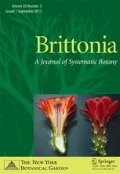Abstract
Various hybrid combinations of 18 species and varieties ofAquilegia were produced, and several cross-pollinations were made which failed to produce hybrids. Pollen fertility of hybrids was generally high, with a total mean of approximately 50%, but highly variable among hybrid combinations and consistently lower than that of parental species. With the exception of frequent occurrence of giant pollen grains and rare synaptic failure of one or two homologous pairs, meiotic behavior in hybrid pollen mother cells appeared to be completely regular.
Representatives of the Vulgaris Complex were observed to be intermediate genetically and morphologically leading to the interpretation of ancestral status among extant species. The greatest genetic diversity within the genus was shown to exist betweenA. ecalcarata and members of the Caerulea Complex.
Similar content being viewed by others
Literature Cited
Anderson, E. 1931. Internal factors affecting discontinuity between species. Amer. Nat.65: 144–148.
—. 1931. Species hybrids inAquilegia. Ann. Bot.45: 639–646.
Boothman, H. S. 1934. Aquilegias. Gard. Chron. (London) III.95: 12, 13.
Clausen, J., D. D. Keck, & W. M. Hiesey. 1945. Experimental studies on the nature of species. II. Plant evolution through amphiploidy and autoploidy, with examples from the Madiinae. Carnegie Inst. Washington Publ.564. 1–174. (cf. pp. 77–79.)
Drummond, J. R., &J. Hutchinson. 1920. A revision ofIsopyrum (Ranunculaceae) and its nearer allies. Kew Bull.1920: 145–169.
Grant, V. 1952. Isolation and hybridization betweenAquilegia formosa andA. pubescens. Aliso2: 341–360.
Kappert, H. 1943. Untersuchungen über Plasmonwirkungen beiAquilegia. (Gynodioecie-Heterosis—Gestalt der Sporns.) Flora137: 95–105.
Kristofferson, K. B. 1922. Studies on Mendelian factors inAquilegia vulgaris. Hereditas3: 178–190.
Linnert, G. 1961. Cytologische Untersuchungen an Arten and Artbastarden vonAquilegia. I. Struktur und Polymorphismus der Nukleolenchromosomen, Quadrivalente und B-Chromosomen. Chromosoma12: 449–459.
Machlis, L., &J. G. Torrey. 1956. Plants in Action. A Laboratory Manual of Plant Physiology. San Francisco: W. H. Freeman & Co. vi + 282 pp. (cf. p. 36.)
Munz, P. A. 1946.Aquilegia. The cultivated and wild Columbines. Gentes Herbarum7: 1–150.
Payson, E. B. 1918. The North American species ofAquilegia. Contr. U. S. Nat. Herb.20: 133–157.
Pelton, Jeanette S. 1957. Evidence of introgressive hybridization and mutation in certain Colorado populations ofAquilegia. Proc. Indiana Acad. Sci.67: 292–296.
Prazmo, W. 1965a. Cytogenetic studies on the genusAquilegia. III. Inheritance of the traits distinguishing different complexes in the genusAquilegia. Acta. Soc. Bot. Poloniae34(3): 403–437.
— 1965b. Cytogenetic studies on the genusAquilegia. IV. Fertility relationships among theAquilegia species. Acta Soc. Bot. Poloniae34(4): 667–685.
Schafer, Brenhilda. 1941. The genetics ofAquilegia vulgaris. Jour. Genetics41: 339–347.
Skalinska, Maria. 1935. Cytogenetic investigations of an allotetraploidAquilegia. Bull. Internat. Acad. Polonaise Sci. & Lettres Ser. B.1: 33–63.
—. 1958. Some attempts to obtain hybrids betweenAquilegia andIsopyrum. Proc. Internat. Congr. Genetics10: 263.
Stebbins, G. L., Jr. 1950. Variation and Evolution in Plants. New York: Columbia Univ. Press. xx + 643 pp.
— 1965. From gene to character in higher plants. Amer. Scientist53: 104–126.
Winge, ö. 1928. Arvelighedslaere paa eksperimentelt og cytologisk Grundlag. Copenhagen: H. Hagerup. 390 pp. (cf. pp. 70, 71.)
Author information
Authors and Affiliations
Additional information
This paper is adapted from a thesis submitted to Washington State University in partial fulfillment of the requirements for the degree of Doctor of Philosophy. The advice and direction of Dr. Marion Ownbey, Professor of Botany and Genetics, is gratefully acknowledged.
Rights and permissions
About this article
Cite this article
Taylor, R.J. Interspecific hybridization and its evolutionary significance in the genus Aquilegia. Brittonia 19, 374–390 (1967). https://doi.org/10.2307/2805535
Issue Date:
DOI: https://doi.org/10.2307/2805535




